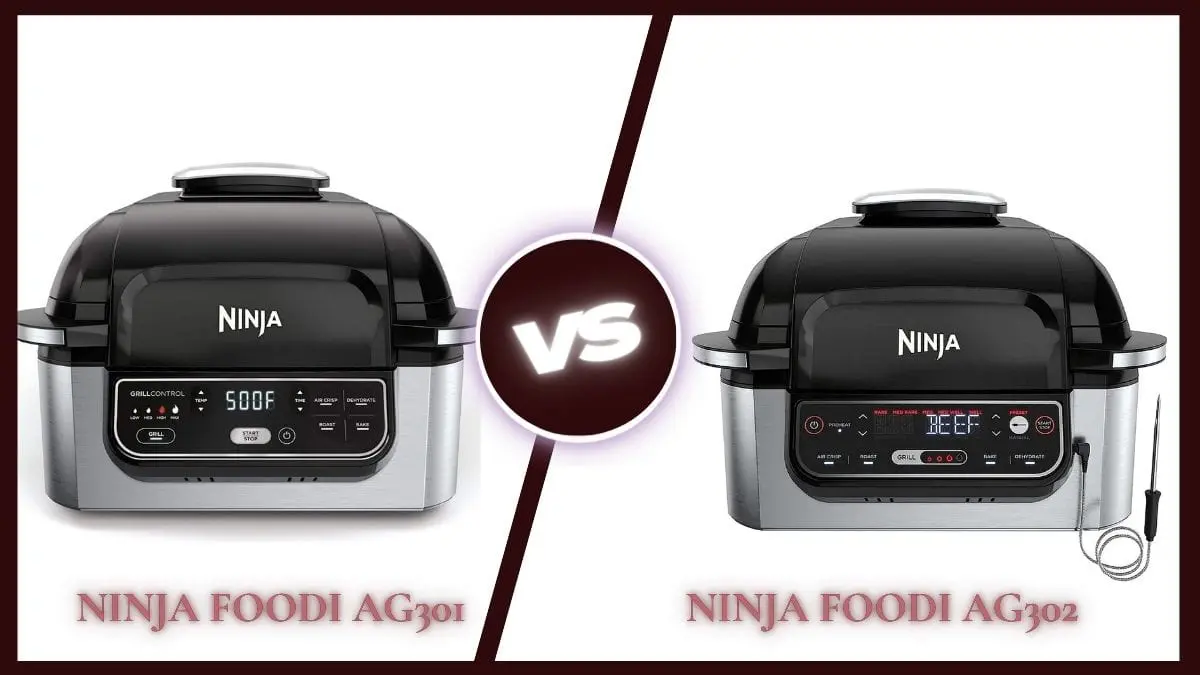If you love crispy, golden food but also care about your health, you’ve probably wondered: Is air frying healthier than deep frying?
Air fryers have exploded in popularity, promising the same crunchy texture as deep-fried food—just with less oil. Meanwhile, deep fryers have been the go-to for decades, delivering unbeatable crispiness and rich flavor. But when it comes to health, the debate gets interesting.
In this post, we’ll break down the nutritional differences, health impact, and taste comparison of air frying vs. deep frying. By the end, you’ll know exactly which one is the better choice for your kitchen.
Understanding Air Frying vs. Deep Frying
Both air frying and deep frying promise crispy, delicious food, but they work in completely different ways. One relies on hot air, while the other uses hot oil. Understanding how each method works can help you see why their health effects differ.
What is Air Frying?
Air frying is like giving your food a super-hot wind tunnel. Instead of submerging food in oil, an air fryer uses rapid air circulation to cook food from all angles. It’s basically a compact convection oven designed to crisp up your food with minimal oil.
The process is simple: You place food in the fryer basket, set the temperature, and let the machine do the rest. A high-powered fan circulates hot air, creating a crispy outer layer while cooking the inside evenly. Since air fryers don’t require much oil—often just a light spritz or none at all—the final result is significantly lower in fat compared to deep-fried food.
But does it taste exactly like deep-fried food? Not always. While air frying gets close, the texture is often lighter, and some foods may turn out drier than their deep-fried counterparts.
What is Deep Frying?
Deep frying, on the other hand, is all about full oil immersion. Food is completely submerged in hot oil (usually between 325°F and 375°F), creating an instant sear on the outside. This process locks in moisture while forming a crispy, golden crust.
Because the food absorbs oil as it cooks, deep frying results in a rich, indulgent flavor and an ultra-crispy texture—something air frying struggles to fully replicate. However, this method also packs on calories and fat. Even when draining food on a paper towel, a significant amount of oil stays in the final dish.
While deep frying isn’t inherently bad, frequent consumption of fried foods has been linked to health concerns like weight gain, high cholesterol, and heart disease. That’s why many people are looking for alternatives, with air frying leading the charge.
Nutritional Comparison – Air Fryer vs Deep Fryer
The cooking method matters when it comes to nutrition. While both air frying and deep frying produce crispy, flavorful food, their impact on calories, fat content, and overall health is very different. Let’s break down the key differences.

Calories and Fat Content
One of the biggest reasons people switch to air frying is to cut down on fat and calories. Deep frying requires food to be fully submerged in hot oil, which means it absorbs a significant amount of fat. This extra fat translates into higher calorie counts—even for the same foods.
Take French fries as an example. A serving of deep-fried fries can contain anywhere from 300 to 500 calories, depending on the portion size and the type of oil used. In contrast, air-fried fries typically contain 150 to 200 calories for the same serving because they require little to no oil.
Here’s a quick side-by-side comparison of some popular foods:
| Food Item | Deep-Fried (Calories & Fat) | Air-Fried (Calories & Fat) |
| French Fries (100g) | ~350 cal, 17g fat | ~180 cal, 4g fat |
| Chicken Wings (6 pcs) | ~700 cal, 40g fat | ~400 cal, 15g fat |
| Breaded Fish Fillet | ~400 cal, 22g fat | ~250 cal, 10g fat |
These numbers vary depending on preparation, but air frying can reduce fat intake by up to 80% compared to deep frying. The reason is simple—air fryers don’t rely on oil immersion. Instead, they use hot air circulation to crisp up food, requiring only a small amount of oil (or none at all).
Impact on Heart Health
Excessive consumption of deep-fried foods has been linked to higher cholesterol levels, heart disease, and obesity. This is largely due to the type and amount of fat used in frying. Many deep-frying oils contain saturated fats and trans fats, which can increase LDL (bad) cholesterol and contribute to clogged arteries over time.
Air frying, on the other hand, significantly reduces unhealthy fat intake. Since it requires little oil, it eliminates a large portion of saturated fats found in deep-fried foods. Plus, you have the flexibility to use healthier oils like avocado or olive oil, which contain beneficial unsaturated fats that support heart health.
However, it’s important to note that air frying isn’t a free pass to eat unlimited fried foods. While it’s a healthier alternative, the best approach is still moderation and balance. Pairing air-fried foods with vegetables, lean proteins, and whole grains ensures a more heart-friendly diet.
Up next, let’s talk about another major health factor—harmful compounds formed during cooking and how air frying and deep frying compare.
Does Air Frying Reduce Harmful Compounds?
Frying food at high temperatures doesn’t just impact calories and fat—it also affects the chemical composition of the food itself. Certain cooking methods can produce harmful compounds that may pose health risks. Two of the biggest concerns with fried foods are acrylamide formation and oil oxidation. Let’s take a closer look at how air frying and deep frying compare in this area.

Acrylamide Formation in Fried Foods
Acrylamide is a potentially harmful compound that forms when starchy foods, like potatoes and bread, are cooked at high temperatures (above 248°F / 120°C). This chemical reaction, known as the Maillard reaction, is what gives fried and roasted foods their golden-brown color and crispy texture. However, studies have linked high levels of acrylamide consumption to an increased risk of cancer in animal studies, raising concerns about its impact on human health.
Deep frying is one of the biggest culprits when it comes to acrylamide production. Since the food is fully submerged in hot oil, it spends more time exposed to high temperatures, allowing acrylamide to form in significant amounts—especially in foods like French fries, potato chips, and breaded items.
Air frying, on the other hand, has been shown to reduce acrylamide levels by up to 90% compared to deep frying. Since air fryers use rapid hot air circulation instead of direct oil immersion, food doesn’t reach the same prolonged high-heat conditions that encourage acrylamide formation. This makes air frying a safer alternative for those looking to minimize exposure to potentially harmful chemicals.
That said, acrylamide formation still occurs in air-fried foods, just at much lower levels. If you want to reduce it even further, try cooking at slightly lower temperatures, avoiding over-browning, and using fresh ingredients instead of pre-packaged frozen options, which tend to produce more acrylamide.
Oxidation of Cooking Oils
The type of oil you use—and how you use it—also plays a role in how healthy (or unhealthy) your fried food is. When oil is heated repeatedly at high temperatures, it undergoes a process called oxidation, which breaks down the oil’s structure and forms harmful compounds like trans fats and free radicals. These substances have been linked to inflammation, heart disease, and other long-term health issues.
Deep frying accelerates oil oxidation, especially when the same oil is reused multiple times. Many restaurants and even home cooks tend to reuse frying oil, which increases the production of degraded fats that are harmful to the body.
Air frying greatly reduces the risk of oil oxidation because it doesn’t require large amounts of oil. Even when oil is used for extra crispiness, it’s applied in small quantities, meaning it doesn’t get reheated and broken down the way deep-frying oil does. Plus, air frying allows you to use healthier oils like avocado oil or extra virgin olive oil, which contain beneficial antioxidants and have higher oxidation resistance.
Taste, Texture, and Cooking Experience
Health benefits aside, the real question is: How does air-fried food compare to deep-fried food in taste and texture? After all, we want our meals to be both healthy and delicious. Let’s break it down.
Which Tastes Better?
If we’re being completely honest, deep frying wins in the flavor department. The reason is simple: oil is a flavor carrier. When food is submerged in hot oil, it develops that rich, indulgent taste we associate with fried foods. The oil seeps into the batter or coating, adding depth and crispiness that’s hard to replicate with air frying.
Air frying does an impressive job at mimicking deep frying, but it’s not an exact match. The texture is often lighter and drier because there’s no oil penetration. While air-fried foods still get crispy, they don’t have the same buttery, melt-in-your-mouth quality that deep-fried foods offer.
That being said, air frying shines when it comes to flavor control. Because you’re not drenching food in oil, the natural flavors of the ingredients come through better. This makes air frying a great option for those who enjoy crispiness without the greasy aftertaste. Plus, you can enhance the taste by seasoning your food properly and using a light coating of oil for extra crunch.
So, if you’re craving restaurant-style fried chicken or classic French fries, deep frying still has the edge. But if you’re looking for a healthier alternative that’s still crispy and satisfying, air frying comes close enough.
Cooking Time and Convenience
Air fryers and deep fryers also differ in terms of ease of use. If you’ve ever deep-fried anything at home, you know it’s not exactly the most convenient cooking method.
Deep frying involves heating a large amount of oil to the right temperature, carefully submerging food, monitoring the cooking process, and then dealing with the messy aftermath. Used cooking oil needs to be disposed of properly, and if you’re not careful, it can create a strong lingering smell in your kitchen. There’s also the risk of oil splatters and burns, which makes deep frying a bit intimidating for some home cooks.
Air frying, on the other hand, is much more beginner-friendly. You simply place the food in the basket, set the temperature and time, and let the machine do the work. There’s no need for oil monitoring, and clean-up is a breeze since most air fryer baskets are dishwasher-safe.
Another big advantage of air fryers is cooking speed. They preheat faster than deep fryers, and because they use convection technology, they cook food evenly in less time. For example, frozen French fries take about 10-15 minutes in an air fryer, while deep frying can take 5-8 minutes, plus extra time to heat the oil.
Which is More Practical for Everyday Cooking?
For day-to-day use, an air fryer is simply more convenient, less messy, and safer than a deep fryer. You can quickly cook meals with minimal supervision, making it ideal for busy lifestyles. While deep frying is great for occasional indulgence, most people find air frying to be the better choice for regular home cooking.
Healthier Cooking Alternatives – Choosing the Right Method
By now, it’s clear that air frying is the healthier option compared to deep frying—but that doesn’t mean it’s the only way to cook delicious food with less oil. If you’re looking to make even healthier choices, there are other cooking methods that can help you enjoy crispy, flavorful meals without sacrificing nutrition.

Is Air Frying Always the Best Choice?
Air frying is a great alternative to deep frying because it significantly reduces calorie and fat intake, lowers the formation of harmful compounds, and is more convenient for everyday cooking. However, it’s still a form of frying, which means it’s not necessarily the healthiest way to prepare food. While air frying is better than deep frying, steaming, baking, roasting, and grilling are even healthier choices in many cases.
For example:
- Baking achieves a crispy texture without the need for extra oil.
- Grilling adds a smoky flavor while allowing excess fat to drip away.
- Steaming preserves the most nutrients, making it ideal for vegetables and lean proteins.
- Roasting enhances natural flavors with minimal oil, making it a great alternative for meats and root vegetables.
If you’re aiming for a well-balanced diet, using a variety of cooking methods—not just air frying—can help you maintain a healthy yet flavorful approach to food.
The Bottom Line – Which One Should You Choose?
If your main goal is healthier fried food, air frying is hands-down the better choice over deep frying. It cuts down on calories, fat, and harmful compounds while still delivering a crispy, satisfying texture. However, deep frying might still be the way to go for those occasional indulgences where taste and texture are the top priorities.
At the end of the day, it’s all about balance. If you love fried food but want to eat healthier, air frying is a fantastic compromise. But for the healthiest approach overall, mixing in baking, grilling, and steaming can help you enjoy delicious meals while keeping nutrition in check.
Related Read: Is Air Fryer Healthier Than Microwave for Your Diet?
Conclusion – Which One is Better for Health?
When it comes down to it, air frying is the healthier choice compared to deep frying. It dramatically reduces fat and calorie intake, lowers the risk of harmful compounds like acrylamide, and eliminates the dangers of repeatedly heated oil. If you’re looking for a way to enjoy crispy foods without the guilt, air frying is the clear winner.
That said, deep frying still has its place—especially when it comes to taste and texture. There’s no denying that deep-fried foods have a richer, more indulgent crunch. But the trade-off is a higher intake of unhealthy fats, more calories, and an increased risk of heart disease if eaten regularly.
Ultimately, the best approach is balance. If you love fried foods, air frying is a great way to enjoy them more often without the negative health effects. But for an even healthier diet, incorporating other cooking methods like baking, grilling, and steaming will help you maintain variety while keeping nutrition in check.
So, is air frying healthier than deep frying? Absolutely. But the healthiest choice of all? Mixing in different cooking techniques and enjoying fried foods in moderation.





